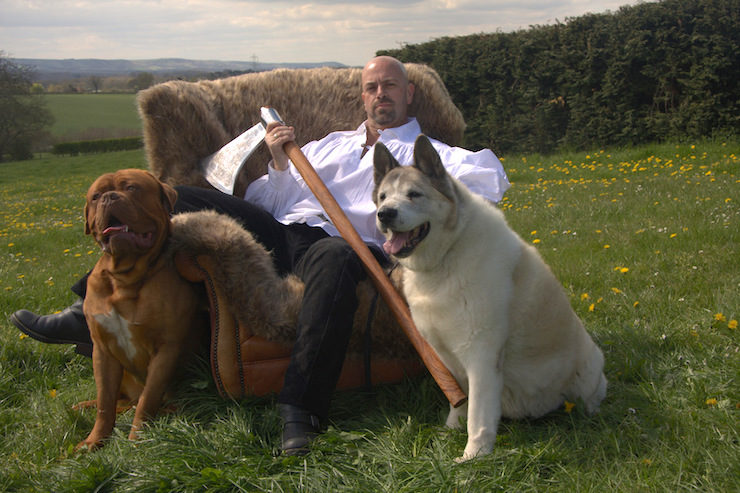Have you ever found yourself ambling around your local bookstore, mumbling as you search the shelves for something – anything – that will fulfill your need for fictional giants mounted on giant bears?
Search no longer, my darlings! I present to you: “The Faithful and the Fallen” fantasy series by British fantasy author John Gwynne.
Beginning with Gemmell Award-winning Malice (Best Debut, 2013), Gwynne’s series is perfect for readers who prefer their fantasy with a touch of grit and darkness (a la the Drenai saga or the Warlord Chronicles) as opposed to the nihilism that the genre is finding particularly fashionable of late. This gorgeously-jacketed quartet – featuring Malice, Valour, Ruin and Wrath – is epic, but not in that sprawling, distant, ‘wait-where-the-hell-am-I-and-who’s-this-character-again?’ sort of way. It’s bloody but not bleak; traditional, but by no means tropey.
Still not convinced? Here’s five more reasons why you might just love it.
1.) The Banished Lands are Eerie, Atmospheric and Beautiful
I don’t know about you, but I often reflect on the fact that there just aren’t enough ‘wyrms’ (with a ‘y’) in fiction these days. And no, I’m not talking about bog-standard dragons who’ve changed their name by deed poll to make themselves sound more interesting. I mean Proper Wyrms, the kind that show up in Germanic myths without wings or even legs and looking like pants-shittingly gigantic– well, worms.
The Faithful and the Fallen respectfully eschews elements of ‘high’ fantasy in favour of more unusual, folklore-inspired creatures. Dragons, elves, wizards and dwarves are nowhere to be seen; nope, instead, the Banished Lands are populated with giants, draigs, fallen angels and—yes!—wyrms. (And giants. Did I mention the giants? Riding bears?)
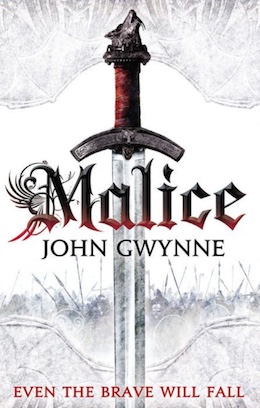 Godless, but green: Gwynne’s settings are, in many ways, unapologetically familiar. Appearing at first glance to be little more than another ‘Medieval Europe’, the Banished Lands are infused with nostalgia and a gentle Germanic ambience that enfolds the reader in a pastoral utopia.
Godless, but green: Gwynne’s settings are, in many ways, unapologetically familiar. Appearing at first glance to be little more than another ‘Medieval Europe’, the Banished Lands are infused with nostalgia and a gentle Germanic ambience that enfolds the reader in a pastoral utopia.
But it’s not long before dark, haunting Celtic overtones start to bleed into the Tolkien-esque quaintness. Gwynne’s descriptions are subtly evocative, and carry a rich sense of history – in a similar vein to the works of Miles Cameron or Mary Stewart – which will appeal to folks who’ve visited the greener, untamed parts of Britain.
A significant part of book two, Valour, takes place in a Romanesque setting, while books three and four (Ruin and Wrath) introduce misty marshes and mighty forests; ancient fortresses and windswept mountain peaks. Such vivid variety is a welcome change from the gorgeous, but overly-comfortable starting location.
With its shifting scenery (cinematically comparable to Game of Thrones, Ironclad, Spartacus and Lord of the Rings) and mixed mythological influences (from talking birds to wolf companions to legendary weapons to GIANTS RIDING BEARS) Gwynne’s saga is much greater than the sum of its parts: and is no less than a brilliant blend of Arthurian motifs and Brythonic lore scaled to epic, Norse-like proportions.
2.) The Characters are Compelling, Because Most of Them Aren’t Bastards
The Faithful and the Fallen is a geographically-sweeping epic full of wicked and wonderful beings. Nonetheless, it remains admirably character-centred.
The quartet begins with just a handful of PoVs – including the ‘main’ protagonist, Corban. But as the story expands, so too does its cast. Gwynne’s structuring of these PoVs is especially smart: he introduces, and shifts between, new voices in a way that ups the complexity and creates excitement rather than confusion.
Honestly, I found Malice to be a little slow, and perhaps a little bit laborious: there are times when excessive detail in the child PoVs becomes repetitive. Having read the entire series, however, I now appreciate the first book’s investment in character-building.
While nowhere near the ‘shades of grey’ you’ll find in books by Mark Lawrence or Rebecca Levene, many of Gwynne’s characters—particularly later in the series—show how easy it is to find oneself on the ‘wrong’ side of a conflict, and how ‘evil’ can be a matter of perspective. It’s particularly interesting to watch some of the protagonists develop and change because of careful manipulation by others.
Here are some of the major players in book one:
CORBAN – Just your average blacksmith’s son. Nothing special about him at all. Nope.
CYWEN – Corban’s fiery knife-throwing sister.
SHIELD – Corban’s badass horse.
STORM – Corban’s big-ass wolf.
CAMLIN – Skilled archer and former brigand; fan favourite.
KASTELL – Unwilling heir; gentle giant-hunter (by which I mean he’s a gentle guy who just happens to hunt giants… not a guy who actively hunts gentle giants).
MAQUIN – Kastell’s loyal retainer and BFF. Also, HE – IS – SPARTACUS!
NATHAIR – The Fresh Prince of Balara; a bit of a tit.
VERADIS – Nathair’s first sword and blood brother (4 lyf).
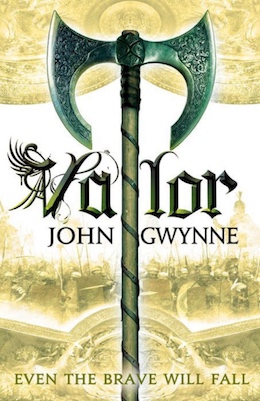 Many of you may roll your eyes at seeing such a male-dominated character list. Rest assured, the gender imbalance is addressed in book two, Valour, with the introduction of more female point-of-view protagonists. And book three, Ruin, is notably populated with strong female characters of all ages, races and stations – as well as one or two non-humans.
Many of you may roll your eyes at seeing such a male-dominated character list. Rest assured, the gender imbalance is addressed in book two, Valour, with the introduction of more female point-of-view protagonists. And book three, Ruin, is notably populated with strong female characters of all ages, races and stations – as well as one or two non-humans.
Malice (and, to some extent, Valour) carefully builds the web of character relationships that is then brought beautifully to the fore in Ruin. No matter how grand the situation or how large the scale, Gwynne never lets us forget that this entire series is a sprawling net comprised of a thousand little strands of humanity – and it’s this that makes it such an engaging and emotional read.
3.) That escalated slowly: The Faithful and the Fallen gets bigger, better, darker
The characters who survive Malice—several of whom were first introduced to the reader as children—grow and develop in interesting (and unusual) ways throughout the series. Corban’s tale is almost a coming-of-age story; except that the ‘farm-boy-with-a-destiny’ (as seen in The Belgariad, The Inheritance Cycle, The Demon Cycle, etc.) generally becomes omni-talented within an insanely short amount of time, and their eventual success is never really in doubt.
Corban, on the other hand, is entirely fallible. Love and loyalty confuse his decisions, and he makes plenty of mistakes along his entire journey (not just at the beginning). Furthermore, the skills he does possess are a result of growing up within a hard-working warrior culture.
But it would be reductive to label The Faithful and the Fallen as ‘Corban’s story’ when Ruin boasts a cast of no less than fourteen point-of-view characters. Unlike A Song of Ice and Fire, however—where you have eighty-nine protagonists spread over a million miles and whom you can easily forget about for entire books at a time—Gwynne’s are surprisingly story-focused. Many PoVs are part of the same group, so that often a change in PoV doesn’t necessarily signify a change in time, or even in location. This works fantastically for making battle scenes tense and pacy, and just overall keeps the pages turning.
(There’s one extended scene near the beginning of Wrath that utilizes this technique perfectly. Short chapters that switch back and forth between two characters left me breathless and desperate to keep reading until the sequence reached its (very satisfying!) resolution.)
I’ve mentioned already that neither Malice nor Valour swept me off my feet. Ruin, however, totally blew me away. By the time you reach book three, you’re invested in the characters and the story, but you’re possibly also wondering if and when the shit is going to hit the fan.
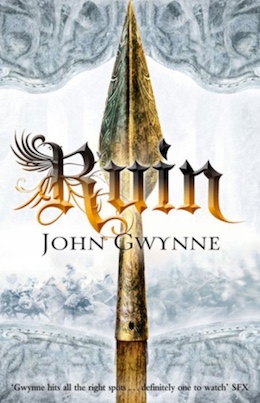 And then you start reading Ruin.
And then you start reading Ruin.
The Banished Lands are at war. No longer charmingly rural, the Celtic settings have become wild and threatening: large parts of Ruin take place in uncharted forests, treacherous marshes and daunting ruins that create a tangible atmosphere of threat and tension. Furthermore, our heroes’ predicament becomes direr with each page you turn; and the author finally gives us a peek inside the minds of some of the series’ most hated characters.
The God-War is not good vs. evil: it’s well-meaning villains and tired refugees; messy skirmishes and small-scale ambushes; confusing conflicts with people on both sides getting lost and making mistakes; losses piling up as constant fighting takes its toll both physically and mentally. The last two books are suffused with a grit and intensity that in the first two books is (for the most part) lacking.
The action comes thick and fast, and it feels as though the reader is right there amongst the combatants: sweating and bleeding and dodging blades and arrows and fists from every quarter. Large-scale battles (which I found distant and impersonal in earlier books) are visceral and immediate, featuring character-driven narratives that make the fighting feel less glorious and more real.
4.) Feels and prose and structure
As the books increase in length and complexity, so too do they become more engaging – a testament to the author’s continually improving skills. Each book is stronger than the last, growing in pace, intensity and sheer readability with every chapter.
I don’t just mean that there’s more action (although there is!). The author’s portrayal of certain characters’ motives and emotions becomes much more powerful, granting the reader intriguing insights into nearly every aspect of the overarching conflict. With so many disparate groups of characters to keep track of, each chapter is a keyhole through which we glean hints of what might happen, and through which we gain numerous perspectives on events.
With perspective comes understanding, and readers will no doubt find themselves surprised by their own changing attitudes towards certain characters. Viewing a battle—along with its associated victories, losses and deaths—from different sides of the conflict brings humanity to every character, no matter how despicable they may seem. And with humanity comes sympathy.
Ruin is one of the very few books that has ever managed to bring me to tears (a reaction previously provoked only by Robin Hobb and Steven Erikson) and I confess to feeling physically sick with nerves at several points during both Ruin and Wrath while I waited to see what became of a beloved character.
What’s truly special about Gwynne’s stories, however, is that they can be tragic without being ‘tragedy’. The Faithful and the Fallen embraces the underlying hope that traditionally characterises the fantasy genre, that sense of an ever-present light amongst the darkness; the hope that good will push back against evil, no matter how grim the situation may seem.
5.) The Author is a Kickass, Axe-Wielding Writing Machine
Clearly influenced by the likes of David Gemmell and Bernard Cornwell, Gwynne’s prose is as economic as it is brutally beautiful.
Even the brave will fall…
If my words have failed to convince you, however, then let’s look at the facts.
Gwynne has released four full-length novels within the last four years. His first quartet is now complete, so you don’t have to worry about cliffhanger endings and decades-long waits! And with a new series (also set in the Banished Lands) slated to begin next year, Gwynne is a solid bet for those who appreciate regular, reliable releases.
Lastly… who wouldn’t want to read books written by this guy? Really? LOOK AT HIM!
6.) It all ends on December 6th 2016
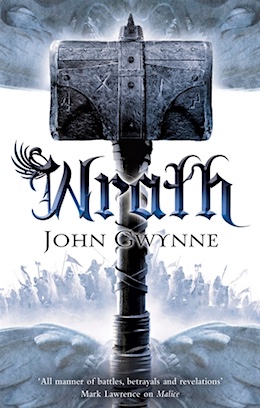 Fans of traditional fantasy will fall in love with The Faithful and the Fallen. Readers who like their fantasy more epic than a flame-breathing oliphaunt, however, should be aware that this series is something of a slow-burn. The weight of history and prophecy and the sheer lore of the world creeps up on the reader rather than smacking them in the face; but although the series takes a little while to get going, before you know it you’ll be hooked. And Wrath is a fitting finale to a worthy series: a spectacularly epic and ambitious tale that delivers everything it promises, and more. Trust me when I say it’s worth the wait.
Fans of traditional fantasy will fall in love with The Faithful and the Fallen. Readers who like their fantasy more epic than a flame-breathing oliphaunt, however, should be aware that this series is something of a slow-burn. The weight of history and prophecy and the sheer lore of the world creeps up on the reader rather than smacking them in the face; but although the series takes a little while to get going, before you know it you’ll be hooked. And Wrath is a fitting finale to a worthy series: a spectacularly epic and ambitious tale that delivers everything it promises, and more. Trust me when I say it’s worth the wait.
So next time you’re in a bookshop and you hear somebody muttering “giants… where are all the giants?” you’ll be able to step in and give them exactly what they need.
Laura M. Hughes exists beneath the grey, pigeon-filled skies of northern England where she reads and writes for Fantasy-Faction and Tor.com. When she isn’t absorbed in playing Dragon Age or working on her first novel, you’re most likely to find her trying to convince unsuspecting bystanders to read The Malazan Book of the Fallen. Hughes encourages like-minded folk to seek her out on Twitter @halfstrungharp and to check out her horror/fantasy novelette, Danse Macabre, on Amazon.










